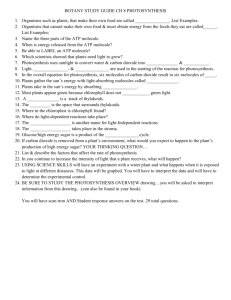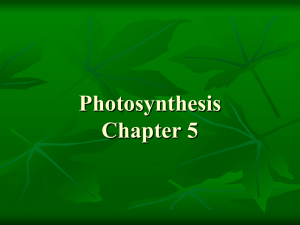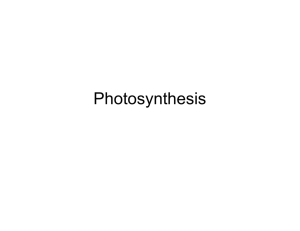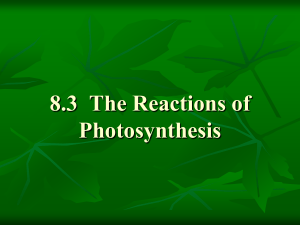of Photosynthesis
advertisement
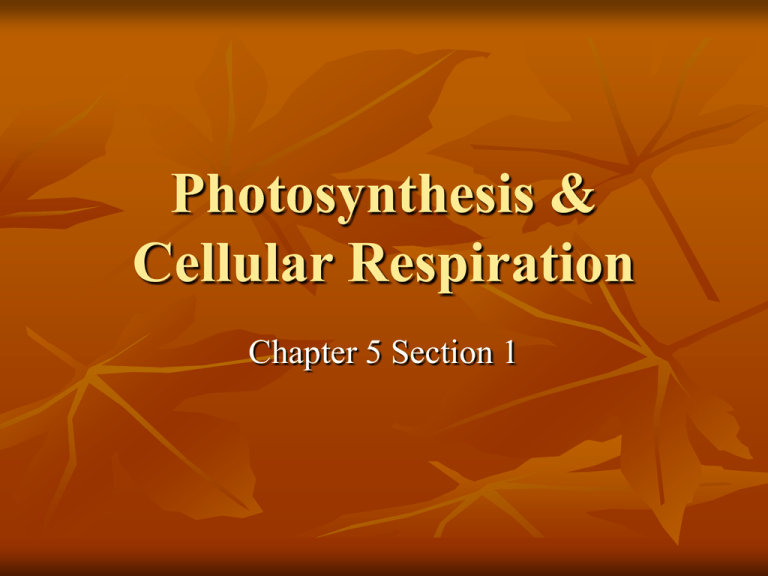
Photosynthesis & Cellular Respiration Chapter 5 Section 1 Objectives Analyze the flow of energy through living systems. Compare the metabolism of autotrophs with that of heterotrophs. Describe the role of ATP in metabolim. Describe how energy is released from ATP. Key Terms Photosynthesis Autotroph Heterotroph Cellular Respiration Capturing the Energy of Life All organisms require energy Some organisms obtain energy directly from the sun This energy is used to make organic compounds that will serve as food for the organisms Autotrophs Organisms that use energy from the sunlight or form chemical bonds in inorganic substances to make organic compounds. Only 10% of the Earth’s 40 million species are autotrophs. Includes plants and some other types of organisms. Also known as producers. Heterotrophs Organisms that must get energy from food instead of directly from sunlight or inorganic substances. Includes animals, humans & even mushrooms. Also known as consumers Flow of Energy Photosynthesis Process in which plants use the energy of sunlight to convert water & carbon dioxide into high-energy carbohydrates (sugars & starches) and oxygen (waste product) Cellular Respiration Process by which cells produce energy from carbohydrates to do chemical work in the cell. ATP Principal chemical compounds that cells use to store and release energy. The only source of energy to do chemical work in the cell. Storing Energy ADP (adenosine diphosphate) is a compound that looks almost like ATP. When a cell has energy available, it can store small amounts of it by adding a phosphate group to ADP molecules. Releasing Energy for Chemical Work Energy is released by breaking the bond between the 2nd and 3rd phosphate. Mitochondria ATP + Enzymes ADP + P+ Energy PHOTOSYNTHESIS Objectives Summarize how energy is captured from sunlight in the first stage of photosynthesis. Analyze the function of electron transport chains in the second stage of photosynthesis. Relate the Calvin cycle to carbon dioxide fixation in the third stage of photosynthesis. Identify three environmental factors that affect the rate of photosynthesis. Key Terms Pigment Chlorophyll Carotenoid Thylakoid Electron Transport Chain NADPH Carbon Dioxide Fixation Calvin Cycle Photosynthesis Carbon dioxide (CO2) requiring process that uses light energy (photons) and water (H2O) to produce organic macromolecules (glucose). SUN photons 6CO2 + 6H2O C6H12O6 + 6O2 glucose Where does Photosynthesis occur? Plants/Autotrophs – produce their own food (glucose) Process called photosynthesis Mainly occurs in the leaves: a. stoma - pores b.mesophyll cells Mesophyll Cell Chloroplast Stoma The Stages of Photosynthesis Stage 1 Stage 2 Energy is captured from sunlight by chlorophyll and other pigments present. Light energy is converted to chemical energy, which is temporarily stored in ATP & the energy carrier molecule NADPH Stage 3 The chemical energy stored in ATP & NADPH powers the formation of organic compounds, using the CO2 to make Glucose. Stages of Photosynthesis The Photosynthesis Equation 6CO2 + 6H20 Carbon Dioxide Water Light C6H12O6 + 6O2 Sugars (High Energy) Oxygen Stage 1: Absorption of Light Energy How does a human eye or leaf absorb light? Visible Spectrum Sunlight contains a mixture of all the wavelengths (colors) of visible light. When sunlight passes through a prism, the prism separates the light into different colors. Visible Spectrum When light strikes an object, it is, absorbed, transmitted or reflected. When all colors are absorbed the object appears black. When all colors are reflected the object appears white. If only one color is reflected the object appears that color. Pigments Light-absorbing substances Absorb only certain wavelengths and reflect all others. Chlorophyll The primary pigment in plants. Absorbs mostly blue & red light Reflects green & yellow light 2 Types of chlorophyll Chlorophyll a - blue green Chlorophyll b -yellow green Carotenoids Accessory pigments: -Carotenoids - orange -Xanthrpphyll – yellow -Anthocyanin – red -Lutein – grey/brown Absorb wavelengths of light different from those absorbed by chlorophyll a & b. Light Absorption During Photosynthesis Thylakoids Saclike photosynthetic membranes located inside the chloroplasts. Arranged in stacks known as grana (singular: granum). Thylakoids When light strikes a thylakoid in a chloroplast, energy is transferred to electrons in chlorophyll, exciting the chlorophyll. This energy transfer causes electrons to jump to a higher energy level. Electrons with extra energy are said to be “excited” Excited Electrons Excited electrons jump from chlorophyll molecules to other nearby molecules in the thylakoid membrane. These electrons must be replaced by other electrons. Plants get these replacement electrons from water molecules. Replacement Electrons Water molecules are split by an enzyme inside the thylakoid. Chlorophyll molecules take the electrons from the hydrogen atoms. Oxygen from the disassembled water molecules combine to form oxygen gas and this is given off at the end of stage 1 as a waste product of photosynthesis. Stage 2: Conversion of Light Energy Light Dependent Conversion of Light Energy Excited electrons that leave chlorophyll molecules are used to produce new molecules, including ATP, that temporarily store chemical energy. Electron Transport Chains Excited electrons are passed through a series of molecules along the thylakoid membrane. This is called the electron transport chain. This provides the energy needed to make ATP. NADPH A second electron transport chain provides energy used to make NADPH NADPH is an electron carrier that provides the high-energy electrons needed to make carbonhydrogen bonds in the 3rd stage of photosynthesis Light-Dependent Reactions Summarized 1. 2. 3. Pigment molecules in the thylakoids of chloroplasts absorb light energy. Electrons in the pigments are excited by light & move through electron transport chains in thylakoid membranes. These electrons are replaced by electrons from water molecules that are split. Light-Dependent Reactions Summarized (cont) 4. 5. Oxygen atoms from water molecules combine to form oxygen gas. Hydrogen ions accumulate inside thylakoids, setting up a concentration gradient that provides the energy to make ATP and molecules of NADPH to be used in the Dark Reaction, the third stage. Stage 3: Storage of Energy “Dark Reaction” Dark Reaction (third stage) of Photosynthesis Carbon atoms from carbon dioxide in the atmosphere and the H molecules from the NADPH of the light reactions are used to make organic compounds in which chemical energy is stored in glucose molecules. The transfer of carbon dioxide to organic compounds (glucose) is called carbon dioxide fixation or the Calvin Cycle. Calvin Cycle Most common method of carbon dioxide fixation. Series of enzyme-assisted chemical reactions that produce a three-carbon sugar. Dark Reaction Summarized 1. 2. Each molecule of carbon dioxide is added to a five-carbon compound by an enzyme using the energy from the ATP and the splitting of the NADPH from the Light Reaction. The resulting six-carbon compound splits into two three-carbon compounds. Phosphate groups from ATP & electrons from NADPH are added to the three-carbon compounds, forming three-carbon sugars. Calvin Cycle Summarized (cont) 3. The resulting three-carbon sugars are used to make organic compounds— glucose —in which energy is stored for later use by the organism. Factors that Affect Photosynthesis Light Concentration of carbon dioxide Rate increases as light intensity increases until all the pigments are being used. Once a certain concentration of carbon dioxide is present, photosynthesis cannot proceed faster Temperature Most efficient within a certain range of temperatures. Question: During the fall, what causes the leaves to change colors? Fall Colors In addition to the chlorophyll pigments, there are other pigments present During the fall, the green chlorophyll pigments are greatly reduced revealing the other pigments Carotenoids are pigments that are either red, orange, or yellow Brought to you by Captain Friday
